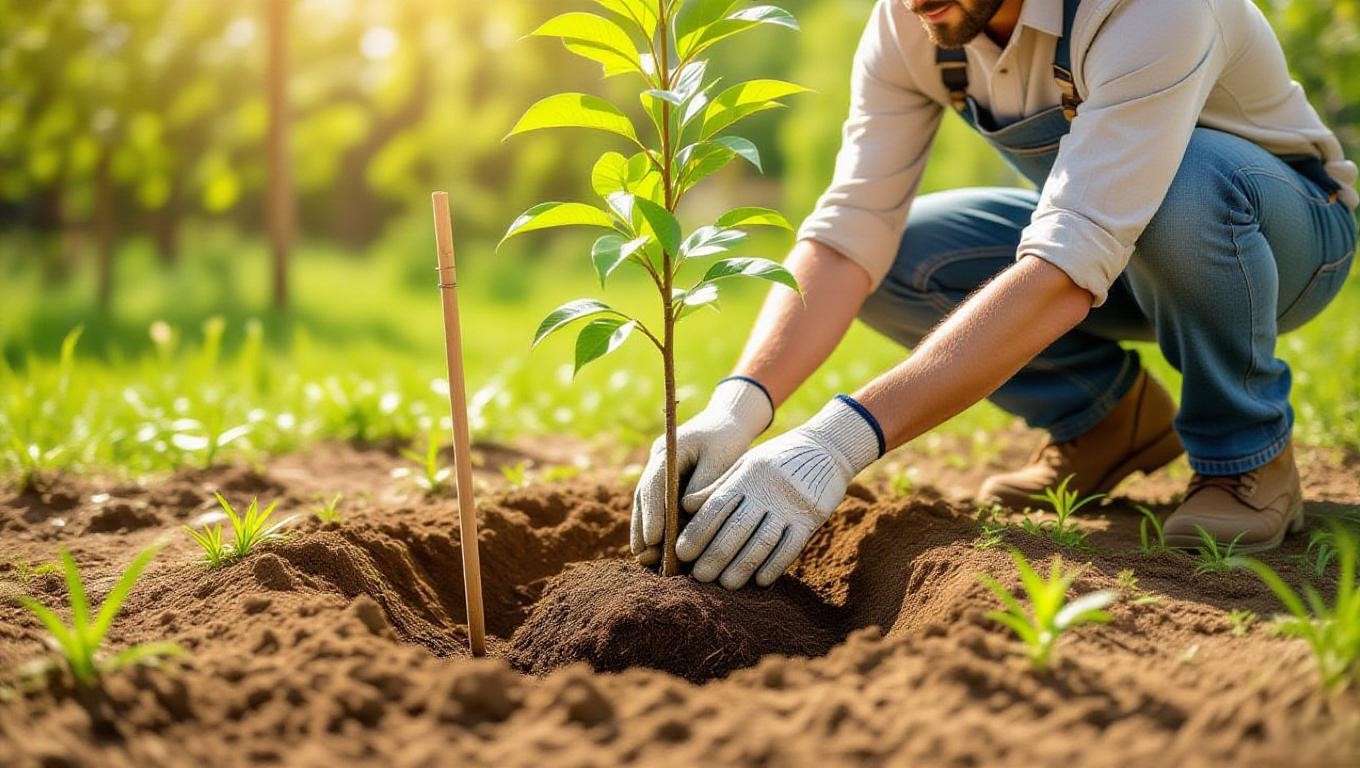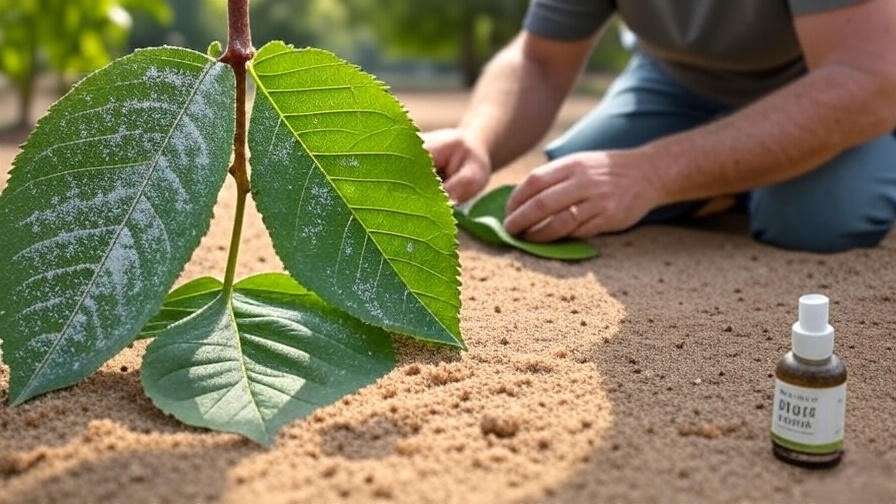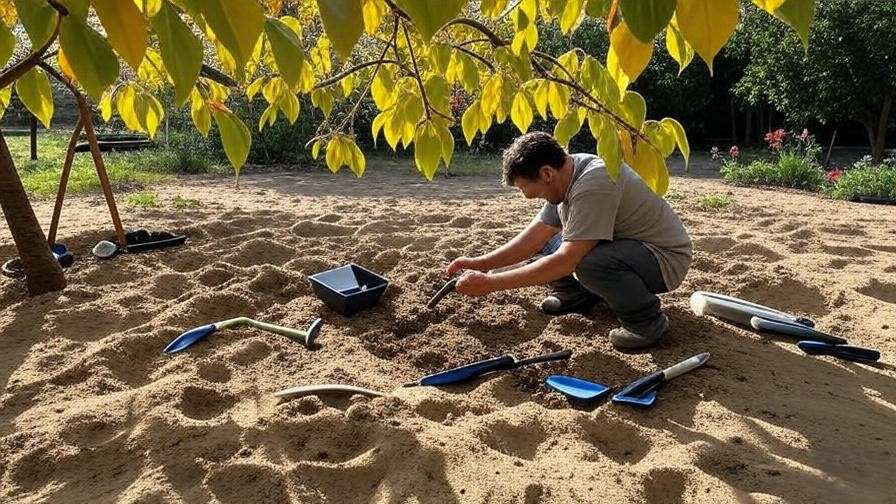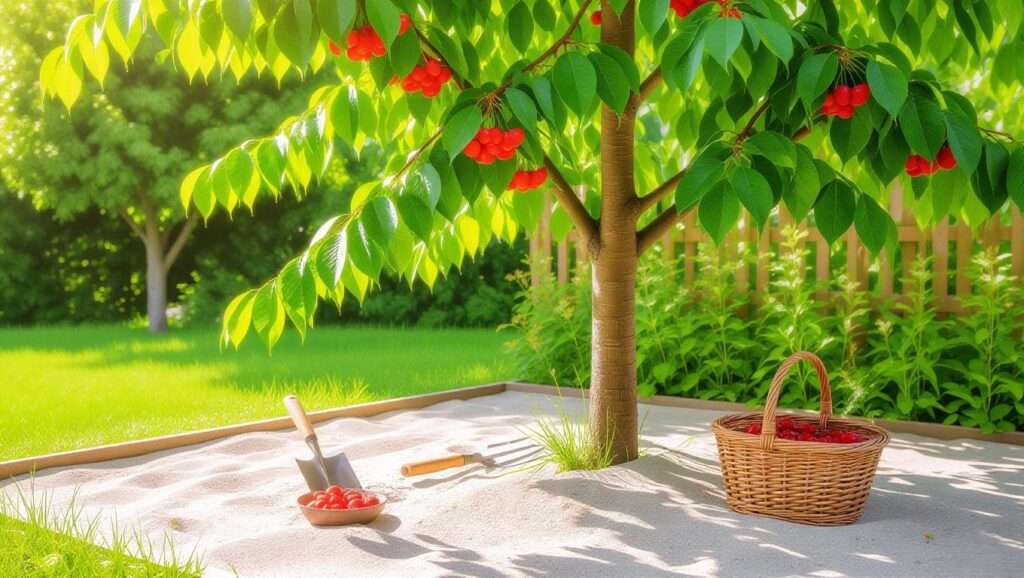Imagine plucking sweet, juicy cherries from your own backyard, even if your garden sits on sandy soil! Growing a healthy cherry tree in sandy soil might seem daunting, but with the right knowledge, it’s entirely achievable. Sandy soil, with its quick drainage and low nutrient retention, poses unique challenges, but these can be overcome with expert strategies. In this comprehensive guide, we’ll walk you through how to grow a healthy cherry tree in sandy soil, from choosing the perfect variety to harvesting your first crop. Backed by 15 years of horticultural expertise and research from top agricultural sources, this article delivers actionable, trustworthy advice to ensure your cherry tree thrives. Ready to transform your sandy plot into a cherry paradise? Let’s dig in! 🍒
Understanding Sandy Soil and Its Challenges 🏜️
What Is Sandy Soil? 🧑🌾
Sandy soil is characterized by its gritty texture, high drainage rate, and low nutrient content. Composed of larger particles than clay or loam, it allows water and nutrients to pass through quickly, which can challenge plant growth. Unlike nutrient-rich loamy soils, sandy soils often require amendments to support fruit trees like cherries. Understanding your soil type is the first step to success, as it informs how you’ll prepare and maintain your cherry tree’s environment.
Why Cherry Trees Struggle in Sandy Soil 🌱
Cherry trees, whether sweet or sour, demand consistent moisture and nutrients to produce vibrant foliage and fruit. In sandy soil, water drains rapidly, leaving roots dry, and nutrients leach away before the tree can absorb them. This can lead to stunted growth, weak root systems, and poor fruit yields. Additionally, sandy soil’s loose structure may not provide the stability cherry trees need, especially in windy areas. However, with proper care, these challenges can be turned into opportunities.
Benefits of Growing Cherry Trees in Sandy Soil 🌞
Despite its drawbacks, sandy soil offers advantages. Its quick drainage reduces the risk of root rot, a common issue for cherry trees in heavier soils. Sandy soil also warms up faster in spring, promoting early growth and potentially extending the growing season. By tailoring your approach—through soil amendments and smart watering—you can leverage these benefits to grow a robust cherry tree.
Choosing the Right Cherry Tree Variety 🍒
Best Cherry Tree Varieties for Sandy Soil 🌳
Not all cherry trees are created equal when it comes to sandy soil. Sweet cherry varieties like Bing and Stella thrive in well-managed sandy conditions, while sour cherries like Montmorency are more tolerant of nutrient-poor soils. Dwarf varieties, such as Compact Stella, are ideal for smaller gardens and easier to manage in loose soil. For best results, choose varieties suited to your climate zone (check USDA hardiness zones) and known for drought tolerance or adaptability.
Where to Source Quality Cherry Trees 🌿
Purchase cherry trees from reputable nurseries or online suppliers certified by organizations like the American Nursery & Landscape Association. Look for disease-resistant varieties and trees grafted onto rootstocks suited for sandy conditions, such as Mazzard or Gisela. Inspect trees for healthy roots and vigorous growth before buying. Local extension services can recommend region-specific suppliers to ensure your tree is adapted to your area’s climate and soil.
Preparing Sandy Soil for Cherry Tree Success 🛠️
Testing and Analyzing Your Soil 🔬
Before planting, test your soil’s pH and nutrient levels. Cherry trees prefer a pH of 6.0–7.0 for optimal nutrient uptake. Use a home soil test kit or send a sample to a local agricultural extension service for detailed analysis. These tests reveal deficiencies in key nutrients like nitrogen, phosphorus, and potassium, which are often lacking in sandy soil. Knowing your soil’s baseline helps you tailor amendments effectively.

Amending Sandy Soil for Optimal Growth 🌾
Sandy soil needs organic matter to improve its water- and nutrient-holding capacity. Incorporate 2–3 inches of compost, aged manure, or peat moss into the top 12 inches of soil. Organic mulches, like wood chips or straw, applied 3–4 inches thick around the tree base, help retain moisture and regulate soil temperature. For long-term improvement, consider adding small amounts of clay or biochar to enhance soil structure. Mix amendments thoroughly to ensure even distribution.
Creating a Nutrient-Rich Planting Site 🕳️
Dig a planting hole twice as wide and as deep as the tree’s root ball (typically 18–24 inches). Mix excavated soil with 30–40% compost and a slow-release fertilizer (e.g., 10-10-10 NPK). Add mycorrhizal fungi to the planting hole to boost root health and nutrient absorption. Ensure the hole has good drainage by checking that water doesn’t pool after a test soak. This preparation creates a nutrient-rich foundation for your cherry tree.
Planting Your Cherry Tree: Step-by-Step Guide 🌱
When to Plant 🌞
Plant cherry trees in early spring or fall when temperatures are mild, allowing roots to establish before extreme heat or cold. In sandy soil, spring planting is often ideal, as it gives the tree time to acclimate before summer drought stress. Check your local climate zone to confirm the best planting window—fall works well in warmer regions (USDA zones 7–9).

How to Plant a Cherry Tree in Sandy Soil 🪴
- Prepare the Hole: Dig a hole as described above, ensuring it’s wide enough for roots to spread.
- Position the Tree: Place the tree so the graft union (the bulge where the rootstock meets the scion) is 2–3 inches above soil level.
- Backfill: Fill the hole with the amended soil mix, gently tamping to remove air pockets.
- Water Thoroughly: Soak the soil to settle it around the roots.
- Stake if Needed: In sandy soil, use a stake to stabilize the tree against wind for the first 1–2 years.
Avoid planting too deeply, as this can suffocate roots, and ensure the root flare is visible above ground.
Post-Planting Care Checklist ✅
- Water deeply (1–2 gallons) immediately after planting and every 2–3 days for the first two weeks.
- Apply a 3-inch layer of mulch, keeping it 2 inches from the trunk to prevent rot.
- Monitor for signs of transplant shock (wilting, yellowing leaves) and adjust watering if needed. If shock persists, consult a local arborist.
Watering and Nutrient Management 💧
Watering Strategies for Sandy Soil 🚿
Sandy soil’s fast drainage means cherry trees need frequent, deep watering. For young trees, provide 5–7 gallons weekly, adjusting based on rainfall. Mature trees may need 10–15 gallons during dry spells. Use drip irrigation or a soaker hose to deliver water directly to the root zone, minimizing evaporation. Check soil moisture 6 inches deep—if it’s dry, water immediately. Overwatering signs include yellowing leaves; underwatering shows as wilting or crispy foliage.

Fertilizing Cherry Trees in Sandy Soil 🌿
Apply a balanced fertilizer (e.g., 10-10-10 or 12-12-12) in early spring before bud break. For young trees, use 1/4 pound per tree, increasing to 1–2 pounds for mature trees. Split applications into two (spring and early summer) to combat nutrient leaching. Organic options like fish emulsion or composted poultry manure work well. Avoid fertilizing late in the season to prevent tender growth before winter.
Expert Tip: Using Compost Tea 🍵
Boost soil fertility with compost tea. Mix 1 gallon of compost with 5 gallons of water, let it steep for 24–48 hours, and strain. Apply 1–2 gallons around the tree’s drip line monthly during the growing season. This delivers microbes and nutrients directly to the roots, enhancing sandy soil’s fertility.
Pruning and Maintenance for Healthy Growth ✂️
Pruning Basics for Cherry Trees 🌳
Pruning is essential for shaping cherry trees, promoting fruit production, and maintaining overall health. By removing dead, damaged, or overcrowded branches, you improve air circulation and reduce disease risk. Prune in late winter or early spring when the tree is dormant, using clean, sharp tools to make precise cuts. For young trees, focus on establishing a strong central leader and well-spaced lateral branches. Mature trees require maintenance pruning to remove suckers, water sprouts, and inward-growing branches. Aim for an open canopy that allows sunlight to reach all parts of the tree.
Ongoing Maintenance Tasks 🧑🌾
- Pest and Disease Checks: Inspect leaves, bark, and fruit monthly for signs of trouble (more details in the next section). Early detection is key in sandy soil, where stress can make trees more vulnerable.
- Mulch Refreshing: Reapply 2–3 inches of organic mulch annually, keeping it away from the trunk to prevent rot. Mulch conserves moisture and suppresses weeds, which compete for nutrients in sandy soil.
- Weed Control: Hand-pull or use a hoe to remove weeds around the tree base. Avoid chemical herbicides near young trees, as they can damage sensitive roots.
- Wind and Sun Protection: In sandy, exposed areas, install a windbreak (e.g., burlap or a temporary fence) for young trees. Use tree wraps to shield trunks from sunburn, common in sunny, sandy regions.
Pest and Disease Management 🐞
Common Pests in Sandy Soil Environments 🕷️
Sandy soil’s warm, dry conditions can attract pests like aphids, cherry fruit flies, and spider mites. Aphids feed on new growth, causing leaves to curl, while cherry fruit flies lay eggs in ripening fruit, leading to maggot infestations. Spider mites thrive in dusty, dry conditions, leaving webbing and stippled leaves. Control methods include:
- Organic Solutions: Spray neem oil or insecticidal soap for aphids and mites. Use yellow sticky traps for fruit flies.
- Cultural Practices: Encourage beneficial insects like ladybugs by planting companion flowers (e.g., marigolds) near your tree.
- Monitoring: Check fruit and foliage weekly during the growing season to catch infestations early.

Diseases to Watch For 🦠
Cherry trees in sandy soil are susceptible to diseases like brown rot, powdery mildew, and bacterial canker. Brown rot causes fruit to rot and twigs to die back, especially in humid conditions. Powdery mildew appears as white patches on leaves, while bacterial canker leads to oozing sores on branches. Prevent and treat diseases by:
- Improving Airflow: Prune to maintain an open canopy, reducing humidity around foliage.
- Fungicides: Apply sulfur-based fungicides for powdery mildew or copper-based sprays for bacterial canker, following label instructions.
- Sanitation: Remove fallen leaves and fruit to prevent disease spread. Disinfect pruning tools between cuts to avoid contamination.
Expert Insight: Integrated Pest Management (IPM) 🌱
Integrated Pest Management (IPM) combines cultural, biological, and chemical controls for sustainable pest and disease management. Start with prevention: choose resistant cherry varieties, maintain soil health, and monitor regularly. Introduce natural predators like lacewings for aphids or parasitic wasps for fruit flies. Use chemical controls as a last resort, opting for low-toxicity options. For example, a grower in California’s sandy Central Valley successfully reduced cherry fruit fly damage by combining sticky traps with timely pruning and beneficial insect habitats, showcasing IPM’s effectiveness.
Harvesting and Enjoying Your Cherries 🍒
When and How to Harvest 🌞
Cherries are ready to harvest when they reach full color (deep red for sweet cherries, bright red for sour) and are firm yet juicy. Taste a few to confirm ripeness, as sandy soil can affect ripening speed. Harvest in the morning when fruit is cool, using scissors or hand-picking to avoid tearing branches. Expect dwarf trees to yield 10–20 pounds of fruit and standard trees 30–50 pounds, depending on age and care. Handle cherries gently to prevent bruising.
Storing and Using Your Cherries 🧺
- Storage: Store fresh cherries in a perforated plastic bag in the refrigerator for up to 3 weeks. Wash just before use to maintain freshness.
- Freezing: Pit cherries and freeze in single layers on a tray, then transfer to airtight bags for up to 6 months.
- Recipes: Turn your harvest into cherry pies, jams, or sauces. For a simple treat, blend frozen cherries with yogurt for a refreshing smoothie.
- Drying: Use a dehydrator to make dried cherries for snacks or baking. Store in airtight containers for up to a year.
Troubleshooting Common Issues ⚠️
Why Isn’t My Cherry Tree Thriving? 🤔
If your cherry tree shows poor growth, yellowing leaves, or low fruit yield, consider these culprits:
- Nutrient Deficiencies: Sandy soil often lacks nitrogen or potassium. Test soil and apply a balanced fertilizer if needed.
- Water Stress: Inconsistent watering can cause leaf drop or small fruit. Ensure deep, regular irrigation.
- Root Issues: Compacted or poorly amended soil can restrict root growth. Loosen soil and add organic matter if growth stalls.

Addressing Sandy Soil-Specific Problems 🏜️
- Excessive Drainage: Counter rapid water loss with drip irrigation and thick mulch layers. Consider a soaker hose for consistent moisture.
- Wind Erosion: Sandy soil is prone to blowing away. Plant ground covers like clover around the tree to stabilize soil.
- pH Imbalances: If soil tests show pH above 7.0 or below 6.0, apply sulfur to lower pH or lime to raise it, following test recommendations.
- Case Study: A gardener in Arizona’s sandy desert turned around a struggling Bing cherry tree by adding 4 inches of compost, installing drip irrigation, and using a windbreak. Within two years, the tree produced 15 pounds of fruit annually.
FAQs: Your Cherry Tree Questions Answered ❓
- How long does it take for a cherry tree to bear fruit in sandy soil?
Dwarf trees may fruit in 2–3 years, while standard trees take 4–5 years, assuming proper care and soil amendments. - Can I grow cherries in extremely sandy soil without amendments?
It’s possible but challenging. Without amendments, yields will be low, and trees may struggle. Adding organic matter is highly recommended. - What’s the best mulch for cherry trees in sandy soil?
Wood chips or straw retain moisture well and break down slowly, enriching the soil over time. - How do I protect my cherry tree from drought?
Use drip irrigation, apply 3–4 inches of mulch, and plant drought-tolerant varieties like Montmorency. - Are there cherry tree varieties that don’t need cross-pollination?
Self-pollinating varieties like Stella or Lapins are ideal for solo planting in sandy soil.
Conclusion: Your Path to a Thriving Cherry Tree 🌳
Growing a healthy cherry tree in sandy soil is within your reach with the right preparation and care. By choosing a hardy variety, amending your soil, watering wisely, and staying vigilant against pests and diseases, you’ll enjoy bountiful harvests for years to come. Start small, stay consistent, and savor the satisfaction of homegrown cherries. Share your cherry tree journey in the comments or reach out for personalized advice! Explore our related articles on fruit tree care and soil management for more tips to grow your garden with confidence. 🍒













